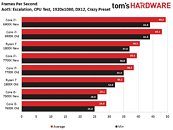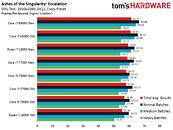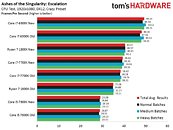Thursday, March 30th 2017

Ashes of the Singularity: Escalation Update Brings Improved Performance to Ryzen
Some outlets are reporting that Stardock's Ashes of the Singularity is about to receive the much-referred-to patch that allows for improved performance on AMD's Ryzen line of processors. If you remember, rivers of ink flowed regarding AMD's Ryzen performance in gaming, with its monstrous, high-performance 8-core, 16-threaded design sometimes delivering performance below expectations. At the time, AMD clarified how Ryzen is a distinctive CPU architecture, similar yet fundamentally different from Intel's x86 implementation, promising upcoming patches from game developers that would allow Ryzen's architecture to truly deliver.
After Creative Assembly and Oxide Games vouched to improve Ryzen support, Oxide seems to be the first developer with a patch available (from version 25624 to 26118) that improves performance by up to 30%. Reportedly, it took the developers around 400 work-hours to improve the game code in respect to its execution on AMD hardware.The update leads to AMD's Ryzen 7 1800X effectively edging out Intel's 7700K in all scenarios, whose better overall gaming performance is the prevailing argument towards preferring the Intel solution. Even so, it would seem that Intel's 6900K still edges out the Ryzen 7 1800X on the Extreme, 1080p preset. But its 7 FPS lead over the 1800X when paired with 2400 MHz DDR4 memory does come with a cost of more than double the 1800X's.
Performance improvements are greater when the Ryzen processors are paired with higher-performing memory (a nod to the way the CCX's Infinity Fabric inter-CCX communication is dependent on memory throughput for increased performance). It would seem that this update improves Ashes' handling of work threads on the Ryzen CPUs, limiting the amount of workload that hops between CCXs - which incurs in a heavy latency penalty for Ryzen processors. Thus, the load on Infinity Fabric would be alleviated, allowing for its increased throughput to carry only game-critical data between both CCXs, whilst not having to also deal with performance-dropping, inter-CCX tread-hopping.
This is an interesting development, which some probably didn't think would actually happen - bold "future performance improvement" claims have been shouted on their way down from rooftops, after all. And while a single developer (out of two who committed to improving performance) doesn't represent an entire industry, it does give AMD credence in its promises of latent performance on their Ryzen CPUs. Best of all: this happens with no performance penalty for AMD's arch-rival Intel processors. We have to wait and see, but fingers crossed for Creative Assembly's changes (when they come, if they come) to join Oxide Games' own improvements opening up the industry to some relevant, platform-specific improvements (and at the same time, agnostic, as in, with no penalties for Intel).
AMD's partnership with Bethesda is looking more and more interesting by the day.
Sources:
Tom's Hardware, PC Perspective
After Creative Assembly and Oxide Games vouched to improve Ryzen support, Oxide seems to be the first developer with a patch available (from version 25624 to 26118) that improves performance by up to 30%. Reportedly, it took the developers around 400 work-hours to improve the game code in respect to its execution on AMD hardware.The update leads to AMD's Ryzen 7 1800X effectively edging out Intel's 7700K in all scenarios, whose better overall gaming performance is the prevailing argument towards preferring the Intel solution. Even so, it would seem that Intel's 6900K still edges out the Ryzen 7 1800X on the Extreme, 1080p preset. But its 7 FPS lead over the 1800X when paired with 2400 MHz DDR4 memory does come with a cost of more than double the 1800X's.
Performance improvements are greater when the Ryzen processors are paired with higher-performing memory (a nod to the way the CCX's Infinity Fabric inter-CCX communication is dependent on memory throughput for increased performance). It would seem that this update improves Ashes' handling of work threads on the Ryzen CPUs, limiting the amount of workload that hops between CCXs - which incurs in a heavy latency penalty for Ryzen processors. Thus, the load on Infinity Fabric would be alleviated, allowing for its increased throughput to carry only game-critical data between both CCXs, whilst not having to also deal with performance-dropping, inter-CCX tread-hopping.
This is an interesting development, which some probably didn't think would actually happen - bold "future performance improvement" claims have been shouted on their way down from rooftops, after all. And while a single developer (out of two who committed to improving performance) doesn't represent an entire industry, it does give AMD credence in its promises of latent performance on their Ryzen CPUs. Best of all: this happens with no performance penalty for AMD's arch-rival Intel processors. We have to wait and see, but fingers crossed for Creative Assembly's changes (when they come, if they come) to join Oxide Games' own improvements opening up the industry to some relevant, platform-specific improvements (and at the same time, agnostic, as in, with no penalties for Intel).
AMD's partnership with Bethesda is looking more and more interesting by the day.





39 Comments on Ashes of the Singularity: Escalation Update Brings Improved Performance to Ryzen
Still even 4 people working on it that's only two weeks of work :)
In terms of rendering performance, the only way to "optimize for Ryzen" would be to remove bloat; removing wasted CPU-cycles. 400 hours to optimize probably means they spent 50-100 hours browsing through the code, a few hours tweaking a few functions and then the remaining in QA. They have clearly found some low-hanging fruit, no one will do a major overhaul of production code for something minor, and that would require >10k hours. Most games would not have enough low-hanging fruit to help out enough.You clearly have never worked on a large software project. Even if you had 400 developers in a code base, just the overhead of starting the work would consume more than 400 hours…
That's why I offered up the more realistic example of a four person team but still I accept I could be wrong about that as well.
Still though they've achieved this improvement with about a month of time with Ryzen, 400 hours over a month isn't all that much especially for a studio that only seems to have the one game to work on.
The games where performance is adequate likely won't be touched.
This means that there's the possibility that there may be more performance gains should a windows patch covering thread scheduling be released later on.
I'm really not surprised Oxide decided to make this patch. They're struggling to sell this game at all... Yet, it always was a favorite of AMD GPU owners, so I'm not surprised Ryzen crowd also had to be taken care of.
I'm sorry to say this, but I don't think these AoS benchmarks are doing any good to Ryzen marketing strategy.
We know that most games today are hardly benefiting from more than 4 cores.
AMD released Ryzen saying that in games it's on par with 6900K (costing twice as much). And it is true, although most graphs ignored the fact that a cheaper 7700K is also in the same league gaming-wise (sometimes faster...).
Now we're back to AoS, which clearly has been optimized for more than 4 cores since release.
But what happened?
Even after this patch Ryzen looks like a competitor to 7700K which has half the cores. 6900K is way faster...
So maybe it's not about games not being optimized for 8 cores? Maybe Ryzen is simply fairly slow and difficult for coders - it only has the multi-thread advantage in some price segments.
At this point I'm quite interested how Ryzen will look when more games make use of 8C/16T potential. :P
BTW:
This test was made using the "Crazy preset" which is said not to change much in terms of gaming experience - it's basically a built-in benchmark. The original Ryzen review used the "Extreme preset" in which the gap between 7700K and 6900K was much wider. I'd prefer to see that one remade - to check where the Ryzen lands this time.
AoS looks and feels like a (heavily multi-thread) benchmark which was later turned into a game. So you can control this vast amount of units and the game is quite challenging technically, but there isn't much else. It lacks a story, design finesse and some brain-challenge as well (other than having to click a lot).
Overall, you could right that this game is too difficult/time-consuming for many to play. As you've said: in time people tend to have other things to do than just playing games.
The issue with AoS is that it also hasn't been BOUGHT very often in the first place. :)